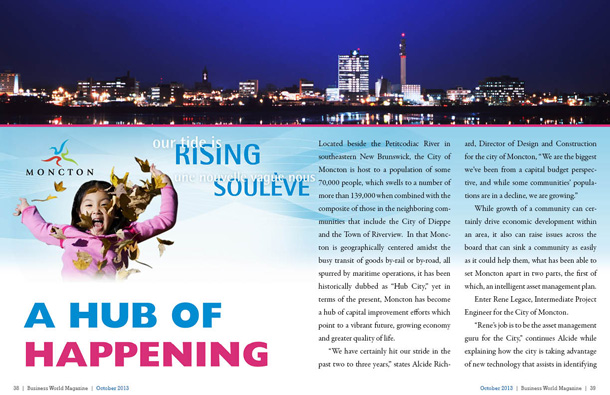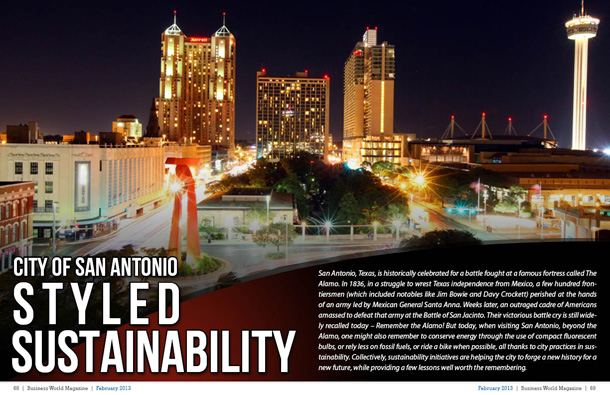
A Hub of Happening

Located beside the Petitcodiac River in southeastern New Brunswick, the City of Moncton is host to a population of some 70,000 people, which swells to a number of more than 139,000 when combined with the composite of those in the neighboring communities that include the City of Dieppe and the Town of Riverview. In that Moncton is geographically centered amidst the busy transit of goods by-rail or by-road, all spurred by maritime operations, it has been historically dubbed as “Hub City,†yet in terms of the present, Moncton has become a hub of capital improvement efforts which point to a vibrant future, growing economy and greater quality of life.
“We have certainly hit our stride in the past two to three years,†states Alcide Richard, Director of Design and Construction for the city of Moncton, “We are the biggest we’ve been from a capital budget perspective, and while some communities’ populations are in a decline, we are growing.â€
While growth of a community can certainly drive economic development within an area, it also can raise issues across the board that can sink a community as easily as it could help them, what has been able to set Moncton apart in two parts, is an asset management plan as well as a financial management plan.
Enter René Lagacé, Intermediate Project Engineer for the City of Moncton.
“René’s job is to be the asset management guru for the City,†continues Alcide, while explaining how the city is taking advantage of new technology that assists in identifying and tracking a matrix relating to rating infrastructure improvements. “The software used tells us where we should be spending our money from a street, water and sewer asset point of view, while also measuring our infrastructure backlog.â€
The city has been able to spend enough to hold the infrastructure deficit year by year as it does not quite spend enough to fully get rid of the backlog, but it’s an increase over where they were and a massive step in the right direction for any community, no matter what size.
This point is further echoed from Gregg Houser, Deputy Treasurer for the City of Moncton, who advises their progress is comparative, if not exceeding, those in major municipalities in Ontario.
“Many Ontario municipalities are having to do asset management plans in order to access infrastructure money from the provincial government,†Mr. Houser advises, “Moncton is on the cutting edge! It may not be an exact science, but this plan gives people an idea of where we’re going to be.â€
The second part of the plan, as mentioned, is an advantageous 30-year financial management plan, aimed to remain sustainable while reducing their backlog. One of the functions making this plan as efficient and unique as it is, is to view projects from a full asset management perspective. As an example, they look holistically at projects with all three components of what the city owns (water, sewer, and street), so if a street needs to be restored or construction work completed, it also assesses the subsequent work that could be completed with water and sewer.
“What’s interesting is that not a lot of municipalities have thirty-year financial plans,†explains Mr. Richard, “Typically we were looking at capital projects in five year cycles, so the program would project out all the money we were expected to spend for five years. What the city is now looking at is a thirty-year cycle, this permits us to project how we can achieve decreasing our backlogs and what that will do to taxes over the next thirty-years.â€
One such notable project is the Sewer System Review and Master Plan. As the result of flooding in the late 1990s, the Master Plan was developed with one of the goals being the understanding of the hydraulic capacity of the system and mitigation of flooding risk. The first phase called for reviewing an area where flooding had occurred, in turn, hydraulic capacity analysis through system modeling was performed. The successful proponent was the Moncton Infrastructure Group (MIG), a consortium of Moncton based engineering consulting firms made up of Genivar, EXP, Crandall Engineering, and Hatch Mott McDonald. The group has been successful through four phases of the Master plan. Phase 5 is being completed this year by EXP with another six to go to cover the entire City. One of the objectives of the Master Plan is ensuring that both the combined and storm sewer systems are equipped with  inlet controlled devices which will only permit the amount of water into their systems that can be handled leaving the rest of the water at the surface, thus greatly reducing sewer back up. Another integral area is looking at improvements to increase sewer capacity by installing storm sewer relief systems or creating detention basins; a system allowing water to collect within a dry basin/pond and slowly discharging it downstream so to alleviate flooding risks.
“The downtown core of the City is mostly comprised of a combined sewer system,†notes René Lagacé. “This means both of the storm and sanitary flows are entering one pipe system, therefore a lot of the recommendations from the Master Plan are to install dedicated storm sewer systems, which not only increases sewer capacity but also provides for sewer separation as an added side benefit, reducing the amount of water processed at the sewage treatment plant.â€
At Work and Play
The city is also analyzing and embracing the next steps for what stands out as one of Canada’s fastest growing urban centers. “There is a desire to construct a new arena facility,†says Houser, adding that the proposed acquisition of a site known as Highfield Square would prove suitable for such development.
In September, the provincial and federal governments, joined by the City of Moncton and the Université de Moncton, announced funding to upgrade the Moncton Stadium.
“Over the years, Moncton has gained the reputation as a sports hub for New Brunswick, attracting world class sporting events,†says Economic Development Minister Paul Robichaud. “We must capitalize on the major events happening at the Moncton Stadium to help rebuild our economy. Moncton will roll out the welcome mat in 2014 for the FIFA Under-20 Women’s World Cup and the 2015 FIFA Women’s World Cup of Soccer and today’s investment will ensure that Moncton has the proper infrastructure in place to host those international events.â€
The provincial government will invest $120,000 through the Regional Development Corporation, while the federal government (through the Atlantic Canada Opportunities Agency) will provide $137,000 under the Community Infrastructure Improvement Fund.
The City of Moncton and the Université de Moncton are each contributing $80,174 towards the project. “The Moncton Stadium has been a key piece in making Moncton the sports and entertainment capital of Atlantic Canada,†says Moncton Mayor George LeBlanc. “These infrastructure improvements will help us continue to attract major national and international events to our region.â€
What a Bore!!
While hosting the World Cup puts Moncton squarely on a platform of international recognition in the sporting world with all the economic possibilities that can pose, the city has also garnered increasing fame among another body of sporting enthusiasts, yet in a manner that was neither intended nor ever expected – with surfers!
To explain, the Petitcodiac River produces one of North America’s few tidal bores, a by-product of its waters interacting with extreme tides emerging from the Bay of Fundy which results in the creation of a large wave that routinely sweeps up the river on the leading edge of the incoming tide. The bore can reach more than six feet in height and extend clear across the width of the river as it moves at speeds that can exceed eight miles an hour. An early tourist attraction, it had vanished from the landscape with the building of the Petitcodiac causeway in the 1960s. As a further consequence, the river channel silted to so reduce the bore that it rarely grew to more than 15–20 cm of height.A few years ago, Moncton and the Provincial government decided to open the causeway gates in an effort to restore the river, and once more, the bore returned to its full glory. Earlier this year, two surfers set a new world record by surfing the 29-kilometre length of the river, the longest ride on a tidal bore ever to be achieved in North America. Surfers from the around the world have since traveled to Moncton, and their exploits have prompted spectators in the tens of thousands. City leaders have discussed plans to develop special events or tournaments around this new venue opportunity, while also cautioning that such practices include risks, not limited to the rocks and shifting of river tides. Such risks have only seemingly added to the want to tackle the challenge by surfer throughout the world, certainly leading to other challenges Moncton will overcome.
As for now, Alcide Richard asserts Moncton is deploying a disciplined view of the future that adheres to intelligent growth and an inherent philosophy of balancing work and play – virtues that will no doubt help this historical hub to maintain its growing renown as a hub of the future.
For more information, please visit their website at: Â City of Moncton
Preferred Vendors of Choice:








